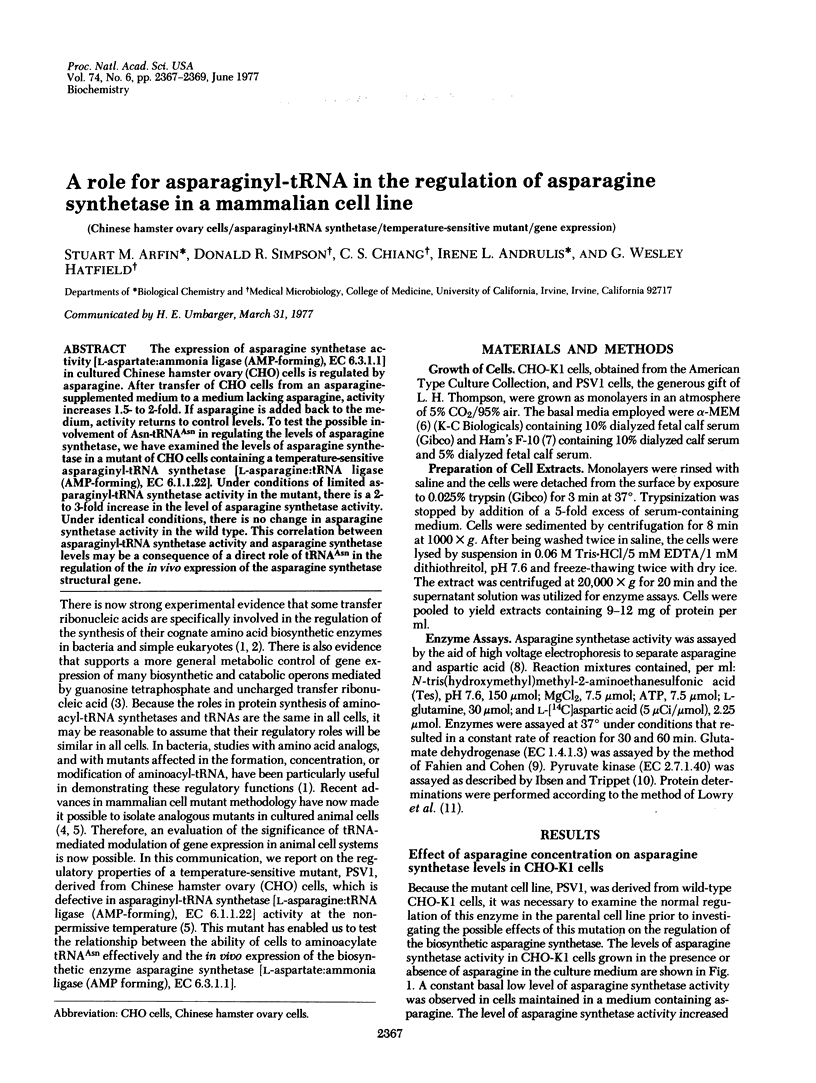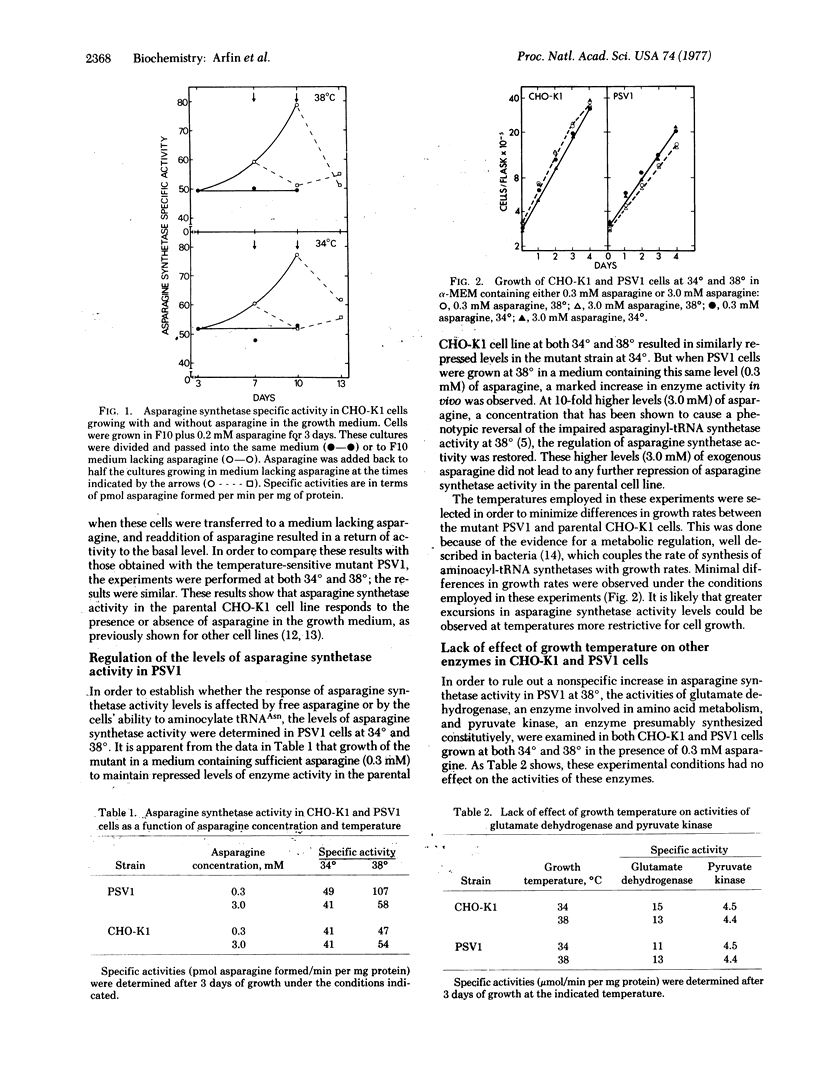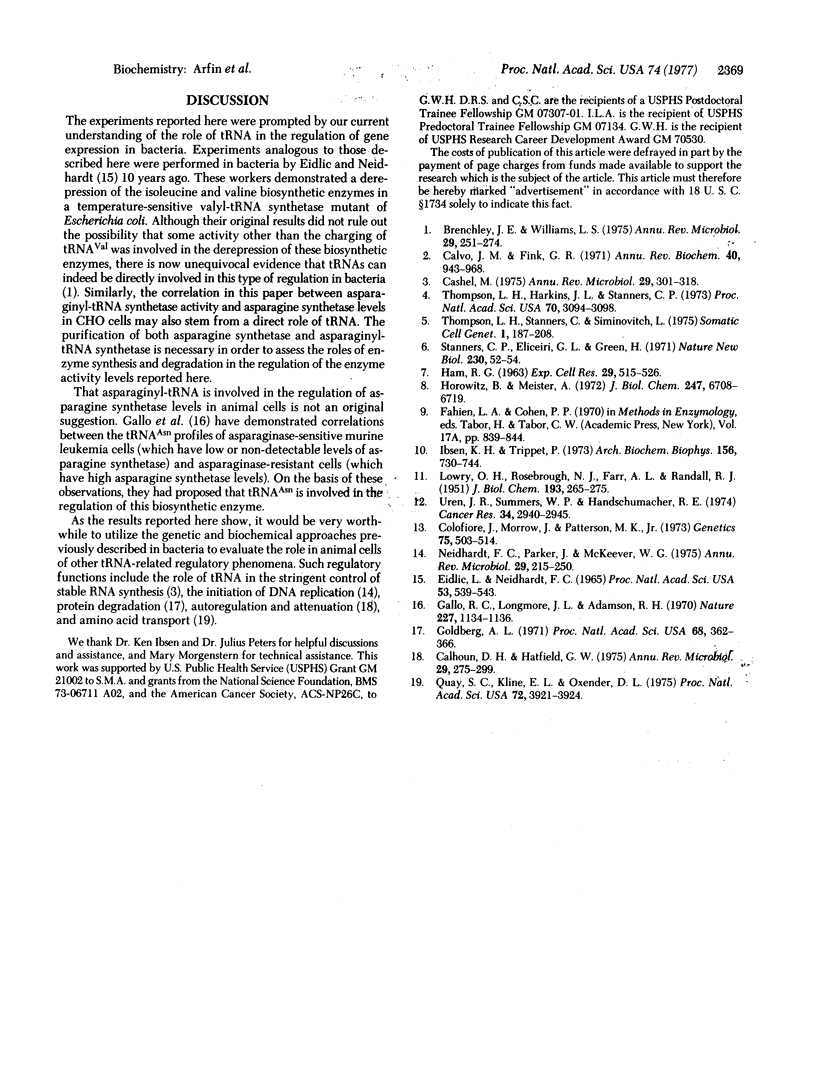Abstract
The expression of asparagine synthetase activity [L-aspartate:ammonia ligase (AMP-forming), EC 6.3.1.1] in cultured Chinese hamster ovary (CHO) cells is regulated by asparagine. After transfer of CHO cells from an asparagine-supplemented medium to a medium lacking asparagine, activity increases 1.5- to 2-fold. If asparagine is added back to the medium, activity returns to control levels. To test the possible involvement of Asn-tRNAAsn in regulating the levels of asparagine synthetase, we have examined the levels of asparagine synthetase in a mutant of CHO cells containing a temperature-sensitive asparaginyl-tRNA synthetase [L-asparagine:tRNA ligase (AMP-forming), EC 6.1.1.22]. Under conditions of limited asparaginyl-tRNA synthetase activity in the mutant, there is a 2- to 3-fold increase in the level of asparagine synthetase activity. Under identical conditions, there is no change in asparagine synthetase activity in the wild type. This correlation between asparaginyl-tRNA synthetase activity and asparagine synthetase levels may be a consequence of a direct role of tRNAAsn in the regulation of the in vivo expression of the asparagine synthetase structural gene.
Full text
PDF


Selected References
These references are in PubMed. This may not be the complete list of references from this article.
- Cashel M. Regulation of bacterial ppGpp and pppGpp. Annu Rev Microbiol. 1975;29:301–318. doi: 10.1146/annurev.mi.29.100175.001505. [DOI] [PubMed] [Google Scholar]
- Colofiore J., Morrow J., Patterson M. K., Jr Asparagine-requiring tumor cell lines and their non-requiring variants: cytogenetics, biochemistry and population dynamics. Genetics. 1973 Nov;75(3):503–514. doi: 10.1093/genetics/75.3.503. [DOI] [PMC free article] [PubMed] [Google Scholar]
- EIDLIC L., NEIDHARDT F. C. ROLE OF VALYL-SRNA SYNTHETASE IN ENZYME REPRESSION. Proc Natl Acad Sci U S A. 1965 Mar;53:539–543. doi: 10.1073/pnas.53.3.539. [DOI] [PMC free article] [PubMed] [Google Scholar]
- Gallo R. C., Longmore J. L., Adamson R. H. Asparaginyl-tRNA and resistance of murine leukaemias to L-asparaginase. Nature. 1970 Sep 12;227(5263):1134–1136. doi: 10.1038/2271134a0. [DOI] [PubMed] [Google Scholar]
- Goldberg A. L. A role of aminoacyl-tRNA in the regulation of protein breakdown in Escherichia coli. Proc Natl Acad Sci U S A. 1971 Feb;68(2):362–366. doi: 10.1073/pnas.68.2.362. [DOI] [PMC free article] [PubMed] [Google Scholar]
- HAM R. G. An improved nutrient solution for diploid Chinese hamster and human cell lines. Exp Cell Res. 1963 Feb;29:515–526. doi: 10.1016/s0014-4827(63)80014-2. [DOI] [PubMed] [Google Scholar]
- Horowitz B., Meister A. Glutamine-dependent asparagine synthetase from leukemia cells. Chloride dependence, mechanism of action, and inhibition. J Biol Chem. 1972 Oct 25;247(20):6708–6719. [PubMed] [Google Scholar]
- Ibsen K. H., Trippet P. A comparison of kinetic parameters obtained with three major non-interconvertible isozymes of rat pyruvate kinase. Arch Biochem Biophys. 1973 Jun;156(2):730–744. doi: 10.1016/0003-9861(73)90326-3. [DOI] [PubMed] [Google Scholar]
- LOWRY O. H., ROSEBROUGH N. J., FARR A. L., RANDALL R. J. Protein measurement with the Folin phenol reagent. J Biol Chem. 1951 Nov;193(1):265–275. [PubMed] [Google Scholar]
- Neihardt F. C., Parker J., McKeever W. G. Function and regulation of aminoacyl-tRNA synthetases in prokaryotic and eukaryotic cells. Annu Rev Microbiol. 1975;29:215–250. doi: 10.1146/annurev.mi.29.100175.001243. [DOI] [PubMed] [Google Scholar]
- Quay S. C., Kline E. L., Oxender D. L. Role of leucyl-tRNA synthetase in regulation of branched-chain amino-acid transport. Proc Natl Acad Sci U S A. 1975 Oct;72(10):3921–3924. doi: 10.1073/pnas.72.10.3921. [DOI] [PMC free article] [PubMed] [Google Scholar]
- Stanners C. P., Eliceiri G. L., Green H. Two types of ribosome in mouse-hamster hybrid cells. Nat New Biol. 1971 Mar 10;230(10):52–54. doi: 10.1038/newbio230052a0. [DOI] [PubMed] [Google Scholar]
- Thompson L. H., Harkins J. L., Stanners C. P. A mammalian cell mutant with a temperature-sensitive leucyl-transfer RNA synthetase. Proc Natl Acad Sci U S A. 1973 Nov;70(11):3094–3098. doi: 10.1073/pnas.70.11.3094. [DOI] [PMC free article] [PubMed] [Google Scholar]
- Thompson L. H., Stanners C. P., Siminovitch L. Selection by [3H] amino acids of CHO-cell mutants with altered leucyl- and asparagyl-transfer RNA synthetases. Somatic Cell Genet. 1975 Apr;1(2):187–208. doi: 10.1007/BF01538547. [DOI] [PubMed] [Google Scholar]
- Uren J. R., Summers W. P., Handschumacher R. E. Enzymatic and nutritional evidence for two-stage exression of the asparagine synthetase locus in L5178y murine leukemia mutants. Cancer Res. 1974 Nov;34(11):2940–2945. [PubMed] [Google Scholar]


